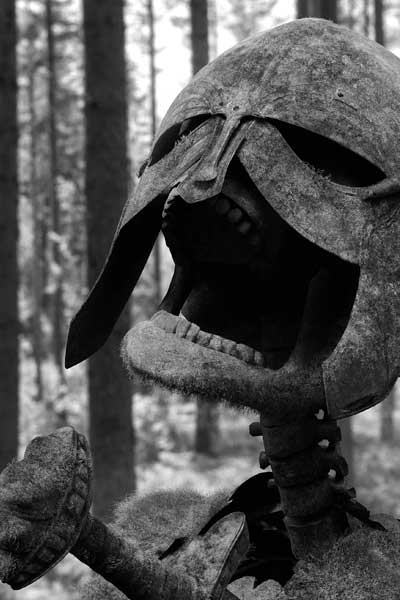
If you think that slasher films and splatter cinema are a modern invention, you’ve probably never heard of the Grand Guignol. A wildly notorious Parisian theater from the late 19th to mid-20th centuries, performances on its stage shocked and thrilled audiences with graphic portrayals of horror, madness, and macabre violence. Specializing in short, sensational plays, Théâtre du Grand-Guignol became synonymous with visceral stagecraft and psychological terror. Even more than 100 years after its founding, the theatre continues to impact stage and film with an enduring legacy of turning gore into an art form.
Founded in 1897 by Oscar Méténier, the Théâtre du Grand-Guignol was a 293-seat venue intended for naturalist performance. A former chapel, the gothic architecture and baroque flourishes of the building gave the space an eerie ambience that the producers quickly leaned into. Every element — from the theater to the sets to the plays themselves — was intended to evoke a strong feelings of fear and grief.
An early precursor to the gimmicky genius of William Castle, theater director Max Maurey worked to leverage the terror and revulsion the audience experienced, turning the extreme emotional catharsis into a marketing ploy. When attendees began fainting or vomiting due to the realistic nature of the gore effects, Maurey had doctors on the floor to make a spectacle of rescuing and reviving the fallen.
By the inter-war period of 1920 to 1940, the Théâtre du Grand-Guignol became one of the most lauded, most notorious venues in Europe. The term Grand Guignol soon spread to other media, including literature, film, and eventually, radio and television.
On a typical evening, theater-goers would sit through half a dozen short, one-act performances. With titles like Mademoiselle Fifi, A Crime in the Mad House, The Ultimate Torture, The Horrible Passion, and The Laboratory of Hallucinations, plays at the theater blended the horrors experienced during the first World War with the moral-free excess of the Victorian Penny Dreadful. These horror plays, filled with bleak endings and over-the-top gore effects, were alternated with lighter, more comedic fair in a system known as “hot and cold showers.” After the audience relaxed a bit with a few laughs, the director would hit them again with a scene of serial mutilation, brutal torture, and even child murder.
Following World War II, the Grand Guignol craze began to wane. In the opinion of its final director, Charles Nonon, the horrors they portrayed onstage could never match the terrible reality of the world around them. After years of diminishing attendance, the Théâtre du Grand-Guignol closed its doors in 1962.
Even though the theater itself has gone, its influence lives on. Many early pulp comics and novels of the early 20thcentury owe their bleak world view and excessive violence to the Grand Guignol school of storytelling. Comic titles such as Tales From the Crypt, The Haunt of Fear, and The Vault of Horror are essentially the theater’s spirit in printed form. This resulted in the infamous Comics Code of the early 1950s which attempted to protect young readers from the sex and gore between the comics’ covers.
Many modern film genres offer a beat-for-beat narrative matching that of the best in Grand Guignol theater. In the 1950s and 60s, renowned movie stars such as Bette Davis, Joan Crawford and Olivia de Havilland played against type with what would later be called Grand Dame Guignol (or Psycho-Biddy Cinema). Movies like What Ever Happened to Baby Jane?, Hush Hush Sweet Charlotte, and Whoever Slew Auntie Roo? brought these aging legends to a new, younger audience. The Hammer and Amicus horror films of the 1960s and 70s attempted to blend the sexual allure of monsters like Count Dracula with the violence and gore those audiences demanded. And for the past twenty years, films like Saw, Hostel, and Martyrs have tried to raise (or perhaps lower) the bar for what the movie-going public can stand on the big screen.
For more on the Théâtre du Grand-Guignol and what is rumored to be a filmed copy of the theater’s final performance, check out this video.

Subscribe to our monthly email newsletter and get a discount code for 10% off your first purchase.